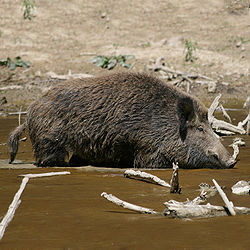- Theria
-
Terios
Rango temporal: Cretácico - Reciente 
Jabalí (Sus scrofa)Clasificación científica Superreino: Eukaryota Reino: Animalia Subreino: Eumetazoa Superfilo: Deuterostomia Filo: Chordata Subfilo: Vertebrata Infrafilo: Gnathostomata Superclase: Tetrapoda Clase: Mammalia Subclase: Theria
Parker & Haswell, 1897Clados subordinados - Ver texto
Los terios (Theria) (del griego θηρίον [thɛː'rion]) son una subclase de mamíferos que se caracterizan porque, a diferencia de los prototerios, el embrión no se desarrolla en el interior de un huevo, sino en el interior del útero materno. Incluye los marsupiales y los placentarios. Aparecieron durante el Cretácico, hace unos 120 millones de años.
Contenido
Infraclases
- Trituberculata †
- Marsupialia (o Metatheria)
- Placentalia (o Eutheria)
Árbol filogenético
Un cladograma resumido:[1]
--o Subclase Theria (Parker & Haswell, 1897) |-- Género Aethomylos Novacek, 1976 (†) |-- Género Anisorhizus Ameghino, 1902 (†) |-- Género Dakotadens Eaton, 1993 (†) |-- Género Falepetrus Clemens & Lillegraven, 1986 (†) |-- Género Kasserinotherium Crochet, 1986 (†) |-- Género Paleomolops Cifelli, 1994 (†) |-- Género Tetraprothomo Ameghino, 1907 (†) |-- Género Tribotherium Sigogneau-Russell, 1991 (†) |-- Género Zygiocuspis Cifelli, 1990 (†) |-- Subfamilia Russellmyinae Estravis, 1990 (†) |-- Familia Endotheriidae Shikama, 1947 (†) |-- Familia Holoclemensiidae Aplin & Archer, 1987 (†) |-- Familia Kermackiidae Butler, 1978 (†) |-- Familia Pappotheriidae Slaughter, 1965 (†) |-- Familia Picopsidae Fox, 1980 (†) |-- Familia Plicatodontidae Ameghino, 1904 (†) |-- Familia Potamotelsidae Nessov, 1987 (†) |-o Orden Asiadelphia Trofimov & Szalay, 1993 (†) |-o Orden Deltatheroida Kielan-Jaworowska, 1982 (†) |-o Cohorte Marsupialia (Illiger, 1811) `-o Cohorte Placentalia (Owen, 1837)
Véase también
Referencias
- ↑ Brands, S.J. (comp.) 1989-2005. Systema Naturae 2000. The Taxonomicon. Universal Taxonomic Services, Amsterdam, Holanda. Acceso: 17 de octubre de 2007
Enlaces externos
 Wikiespecies tiene un artículo sobre Theria. Wikispecies
Wikiespecies tiene un artículo sobre Theria. Wikispecies
Wikimedia foundation. 2010.
